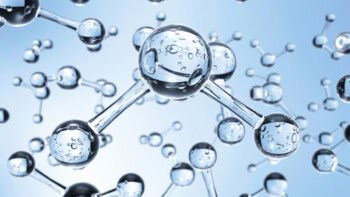
The first highly-conductive connection between a single organic molecule and a metal electrode has been made by an international team of physicists. This achievement could lead to the development of ‘molecular electronics’ devices with the potential to be smaller and faster than conventional transitors and logic gates.
The majority of electronic devices are made from just a handful of semiconductor materials — the most common being silicon. However, some organic molecules such as DNA appear to have electronic properties similar to traditional semiconductors and some researchers believe that some types of molecules could be used to make electronic devices.
A potential benefit of such devices is that molecules are extremely small compared to semiconductor structures, which could help manufacturers pack more and more circuits onto a chip.
However, it has proven very difficult to connect single molecules to a metal electrode such that electrons are conducted easily between the two. These junctions are essential for making real-world devices like transistors and logic gates.
Significant barrier
Previous attempts at making single-molecule junctions involved using “anchoring groups” such as thiols to bind organic molecules to metal electrodes like gold. However, the metal-molecule link creates a significant potential barrier across the junction and electrons end up tunnelling across the molecule when a voltage is applied between the electrodes. This inevitably leads to a low conductivity, and thus poor performance in the finished devices.
A higher conductance would be possible if electrons were allowed to travel ‘ballistically’ across the metal-molecule junction – whereby every electron that enters the junction travels straight through more or less unhindered. This occurs in many carbon nanotube devices or single-atom contacts, which reach the quantum of conductance — the maximum conductance possible for a single electron channel. However, this has never been achieved in single-molecule junctions before.
Now, Jan van Ruitenbeek of the University of Leiden in the Netherlands along with colleagues in Australia, Germany and Spain may have solved this problem by making the first highly conductive molecular junctions. This involved binding benzene molecules directly to platinum metal electrodes, and the team found that the conductance of these devices reaches the maximum value possible for a single electron channel.
Direct coupling
The physicists showed that it is possible to couple the metal electrodes, in their case platinum, ‘directly’ to the carbon backbone of an organic molecule (benzene), which allows the electrons to travel more easily across the junction. Indeed, the conductance of the junction has a value of G0, which equals 2e2/h, where e is the charge on the electron and h is Planck’s constant. This is the maximum conductance possible for a single electron channel — around 7.7 x 10-5 ohm-1 (Phys Rev Lett 101 046801).
The researchers say that they regard benzene as a “starting point” for building such molecular junctions and they will soon be investigating more advanced organic compounds. Benzene is ideal for such early work because it is a simple system that can be easily studied using techniques like vibration mode spectroscopy, isotope substitution, shot noise measurements and local density functional computations.
The team achieved its results using mechanically controllable “break junctions”, which allowed them to produce atomic-sized junctions of any metal at liquid helium temperatures. Once the scientists had verified that the junction was clean, they introduced benzene vapour through a capillary tube onto the structures. They observed the molecules arriving at the junction by measuring the change in conductance properties of the device. The junction was then stretched to nearly breaking point so that a molecular bridge spontaneously formed across it.
Detailed investigations
“The most important property of these junctions is that their conductance is at least an order of magnitude higher than comparable junctions made using thiol anchoring groups,” van Ruitenbeek told physicsworld.com. “Under our experimental conditions, the junctions can be held stable for a very long time, which, when combined with the cryogenic temperatures used, allows us to make detailed investigations.”
The team now plans to study metals other than platinum, which is expensive, for use in molecular electronics applications.
“What makes this work stand out is that [the scientists] have presented a new way to attach organic molecules to metal electrodes, by forming a direct metal-carbon bond, and have proven conclusively that their devices have a strong metal-molecule link,” commented Latha Venkataraman of Columbia University in an American Physical Society Viewpoint article on the research. “This enables them to overcome a major barrier in molecular based devices,” she said.



